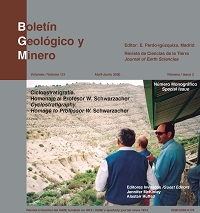Estimation of the ages of Devonian and Cretaceous stage boundaries in the Geologic Time Scale
DOI:
https://doi.org/10.21701/bolgeomin.131.2.006Keywords:
GTS2012, spline-curve fitting, Neogene, Milankovitch cyclesAbstract
Estimation of the ages of period and stage boundaries of the Geologic Time Scale (GTS) has a long history that commenced over a century ago with the pioneering work of Arthur Holmes. Frequencies, precision and accuracy of radiogenic isotope age determinations used for time scale construction continue to increase steadily. Later stage boundary age estimates are accompanied by error bars based on 2-sigma age dating errors with incorporation of stratigraphic uncertainty. Most GTS2004 and GTS2012 results involved spline-curve fitting. In GTS2012, Milankovitch-type orbital climate cyclicity was used to tune the Neogene geologic time scale while seafloor spreading was combined with sedimentary cycle scaling to construct the Paleogene time scale, and it also contributed to the construction of the Cretaceous and Jurassic time scales. Geomathematical procedures continue to be refined for the next GTS which is in Gradstein et al. (2020). In this study smoothing splines are used to construct Devonian and Late Jurassic - Early Cretaceous time scales. This methodology and its results are described and some estimates are refined by incorporating Milankovitch cycle durations.
Downloads
References
Agterberg, F.P. 1974. Geomathematics. Elsevier, Amsterdam, 596 pp. Agterberg, F.P. 2002. Construction of numerical geological time scales. Terra Nostra, 04/2002, 227-232.
Agterberg, F.P. 2004. Geomathematics. In: Gradstein, F.M., Ogg, J.G, and Smith, A.G. (eds.), A Geologic Time Scale 2004. Cambridge University Press, Cambridge, pp. 106-125. https://doi.org/10.1017/CBO9780511536045.009
Agterberg, F.P., Hammer, O. and Gradstein, F.M. 2012. In: Gradstein, F.M., Ogg, J.G., Schmitz, M.D. and Ogg, G.M. (eds.). The Geologic Time Scale 2012. Elsevier, Amsterdam, pp. 269-273. https://doi.org/10.1016/B978-0-444-59425-9.00014-7
Becker, R.T. et al. in press. The Devonian. In: Gradstein, F.M. et al. (eds.), A Geologic Time Scale 2020. https://doi.org/10.1016/B978-0-12-824360-2.00022-X
Chambers, J.M. and Hastie, T.J 1992. Statistical Models in S. Wadsworth, S. and Brooks/Cole, London, 608 pp.
Cooper, R.A. 1999, The Ordovician time scale - calibration of graptolite and conodont zones. Acta Universitatis Carolinae Geologica, 43(1/2), 1-4.
De Vleeschouwer, D. and Parnell, A.C. 2014. Reducing timescale uncertainty for the Devonian by integrating astrochronology and Bayesian statistics. Geology, 42(6): 491-494. https://doi.org/10.1130/G35618.1
Gale, A,S, Mutterlose, J. and Batenburg, S. in press. The Cretaceous. In: Gradstein, F.M. et al. (eds). A Geologic Time Scale 2020. Getis, A. and Ord, J.K. 1992. The analysis of spatial association by use of distance statistics. Geographical Analysis, 24(3): 189-206. https://doi.org/10.1111/j.1538-4632.1992.tb00261.x
Gradstein, F.M., Ogg, J.G. and Smith, A.G. (eds.) 2004. A Geologic Time Scale 2004. Cambridge University Press, Cambridge, 589 pp. https://doi.org/10.1017/CBO9780511536045
Gradstein, F.M., Ogg, J.G., Schmitz, M.D. and Ogg, G.M., eds. 2012. The Geologic Time Scale 2012. Elsevier, Amsterdam, 1144 pp.
Gradstein, F.M., Ogg, J.G., Schmitz, M.D. and Ogg, G.M., eds. 2020. The Geologic Time Scale 2020. Elsevier, Amsterdam. https://doi.org/10.1127/nos/2020/0634
Hastie, T.J. and Tibshirani, R.J. 1990. Generalized Adaptive Models. Chapman and Hall, London, 328 pp.
Harland, W.B., Cox, A.V., Llewellyn, P.G., Pickton, C.A.G. Smith, A.G. and Walters, R. 1982. A geologic time scale. Cambridge University Press, Cambridge, 131 pp.
Harland, W.B., Armstrong, R.L., Cox, A.V., Craig, L.A., Smith, A.G. and Smith, D.G. 1990. A geologic time scale 1989. Cambridge University Press, Cambridge, 263 pp.
Kent, D.V. and Gradstein, F.M. 1985. A Cretaceous and Jurassic geochronology. Geol. Soc. America 96, 1419-1427. https://doi.org/10.1130/0016-7606(1985)96<1419:ACAJG>2.0.CO;2
Kent, D.V., and Gradstein, F.M. 1986. A Jurassic to Recent geochronology. In: Vogt, P.R. and Tucholke, B.E. (eds.), The Geology of North America. Vol. M, The Western North Atlantic Region. Boulder: Geological Society of America, 45-50. https://doi.org/10.1130/DNAG-GNA-M.45
McKerrow, W.S., Lambert, R.S.J. and Cocks, L.R.M. 1985. The Ordovician, Silurian and Devonian Periods. In Snelling, N.J. (ed.), The chronology of the geological record. Geological Society of London, Memoir 10, 73-80. https://doi.org/10.1144/GSL.MEM.1985.010.01.08
Obradovich, J.D. 1993. A Cretaceous time scale. In Caldwell, W.G.E. and Kaufman, E.G. (eds.), Evolution of the Western Interior Basin. Geological Association of Canada Special Paper, 379-396.
Schwarzacher, W. 1993. Cyclostratigraphy and the Milankovitch theory. Elsevier, Amsterdam, 225 pp.
Tiraboschi, D., Erba, E. and Jenkyns, H.C., 2009. Origin of rhythmic-Albian black shales (Piobboco core, central Italy): Calcareous nannofossil quantitative and statistical analysis and paleoceanographic reconstructions. Paleoceanography and Paleoclimatology 24, 23 June 2009. https://doi.org/10.1029/2008PA001670
Wahba, G. 1985. A comparison of GCV and GNL for choosing the smoothing parameters in the generalized spline smoothing problem. Annals of Statistics 4, 1378-1402. https://doi.org/10.1214/aos/1176349743
Wang, Y. 2011. Smoothing splines. Methods and applications, Monographs on Statistics and Applied Probability, 121. CRC Press, Boca Baton, Florida, 370 pp.
Downloads
Published
How to Cite
Issue
Section
License
Copyright (c) 2024 Consejo Superior de Investigaciones Científicas (CSIC)

This work is licensed under a Creative Commons Attribution 4.0 International License.
© CSIC. Manuscripts published in both the print and online versions of this journal are the property of the Consejo Superior de Investigaciones Científicas, and quoting this source is a requirement for any partial or full reproduction.
All contents of this electronic edition, except where otherwise noted, are distributed under a Creative Commons Attribution 4.0 International (CC BY 4.0) licence. You may read the basic information and the legal text of the licence. The indication of the CC BY 4.0 licence must be expressly stated in this way when necessary.
Self-archiving in repositories, personal webpages or similar, of any version other than the final version of the work produced by the publisher, is not allowed.















